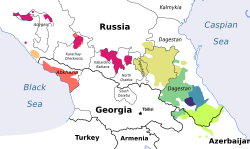This article needs additional citations for verification .(January 2010) |
| Northwest Caucasian | |
|---|---|
| West Caucasian Abkhazo–Circassian Abkhaz–Adyghean North Pontic Pontic | |
| Geographic distribution | Ciscaucasia in Eastern Europe |
| Linguistic classification | One of the world's primary language families |
| Proto-language | Proto-Northwest Caucasian |
| Subdivisions | |
| Language codes | |
| Glottolog | abkh1242 |
 Circassian Abazgi Ubykh (extinct) | |
The Northwest Caucasian languages, [1] also called West Caucasian, Abkhazo-Adyghean, Abkhazo-Circassian, [2] Circassic, or sometimes Pontic languages (from Ancient Greek, pontos, referring to the Black Sea, in contrast to the Northeast Caucasian languages as the Caspian languages), is a family of languages spoken in the northwestern Caucasus region, [3] chiefly in three Russian republics (Adygea, Kabardino-Balkaria, Karachay–Cherkessia), the disputed territory of Abkhazia, Georgia, and Turkey, with smaller communities scattered throughout the Middle East.
Contents
- Main features
- Phonetics
- Grammar
- Classification
- Circassian dialect continuum
- Abkhaz–Abaza (Abazgi) dialect continuum
- Ubykh
- See also
- References
- Citations
- Sources
- Further reading
- External links
The group's relationship to any other language family is uncertain and unproven. One language, Ubykh, became extinct in 1992, while all of the other languages are in some form of endangerment, with UNESCO classifying all as either "vulnerable", "endangered", or "severely endangered". [4]
The Northwest Caucasian languages possess highly complex sets of consonant distinctions paired with a lack of vowel distinctions, often providing archetypical cases of vertical vowel systems, also known as "linear" vowel systems. [5] [6]


